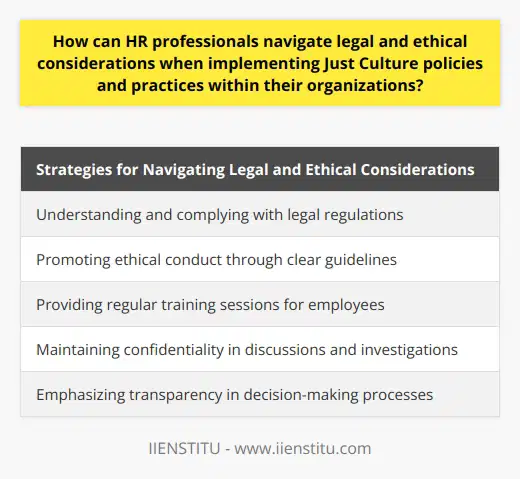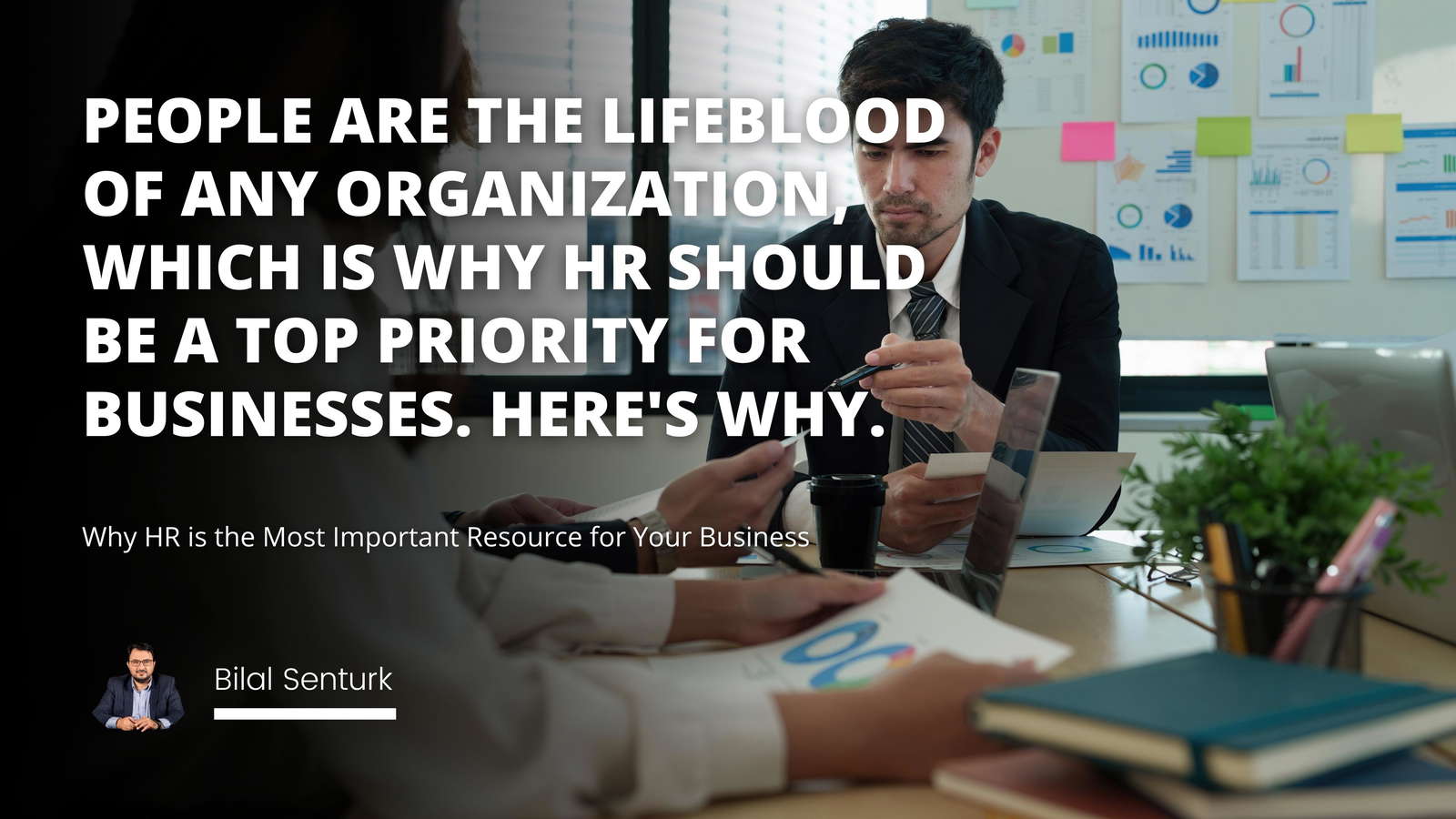
As I sat in my favorite corner coffee shop, sipping on a latte and observing the bustling crowd, I couldn't help but reflect on the complex tapestry that is today's workplace. Business, in all its forms, has always been a driving force of innovation and economy. Yet, beneath the surface of quarterly reports and productivity metrics lies a more profound narrative--one that deals with human interactions, microaggressions, and the quest for a just culture within organizations.
Historical Perspective
Growing up, I often heard stories from my grandparents about their experiences in the workforce during the mid-20th century. The workplace back then was a different beast altogether. Overt discrimination, blatant gender biases, and a lack of human resource (HR) policies that protect employees were, unfortunately, the norms. My grandmother would recount how women were expected to fetch coffee for meetings, regardless of their position or qualifications.
The civil rights movement and subsequent legislation in the latter half of the 20th century brought about significant changes. Violence and discrimination against people of color, gender, and ethnicity became illegal, paving the way for more inclusive workplaces. However, while the overt displays of prejudice have diminished, they have not been completely eradicated. Instead, they've often transformed into more subtle forms, known as microaggressions.
Introduction
Historical Perspective
Microaggressions in the Workplace
Creating a Just Culture
The Friedman Doctrine
Understanding Microaggressions in the Workplace
Microaggressions are the everyday, subtle, intentional--or oftentimes unintentional--interactions or behaviors that communicate some sort of bias toward historically marginalized groups (Sue, 2010). I recall a close friend of mine, Jamal, sharing his experiences at a tech startup. Despite holding a degree from a prestigious university and having several years of experience, he was frequently mistaken for a junior employee. Colleagues would express surprise at his technical expertise with comments like, "Wow, you speak so well for someone from your background."
These seemingly innocuous remarks are, in fact, laden with assumptions and stereotypes. Making assumptions about an individual's capabilities or qualifications based on race, gender, or ethnicity undermines their accomplishments and can erode their confidence over time.
Examples of Microaggressions
1- Assuming a woman in a meeting is in a junior role, such as a note-taker or assistant, rather than a decision-maker.
2- Commenting on someone's accent or language proficiency, suggesting that it's unusual for them to be articulate.
3- Excluding colleagues from informal gatherings or networking opportunities based on cultural differences.
4- Using culturally insensitive jokes or remarks, even if meant humorously.
5- Questioning the validity of someone's feelings or experiences related to discrimination.
These actions, while subtle, contribute to a workplace environment that feels unwelcoming and can have significant psychological impacts.
The Impact of Microaggressions on Employees and Organizations
The effects of microaggressions extend beyond the individual--they ripple through the organization, affecting morale, productivity, and ultimately, the bottom line.
On Employees
1- Increased Stress and Anxiety: Constant exposure to microaggressions can lead to heightened stress levels. Employees may feel they are constantly on guard, anticipating the next slight.
2- Decreased Job Satisfaction: Feeling undervalued or marginalized can diminish an employee's satisfaction with their job and the organization.
3- Impaired Mental Health: Prolonged experiences can contribute to depression, anxiety disorders, and a sense of isolation.
I remember attending a seminar where a speaker shared her story about leaving a promising career because the accumulation of microaggressions became unbearable. She felt "alienated" and "resentful," ultimately deciding that her well-being was more important than staying in a toxic environment.
On Organizations
1- Reduced Productivity: Employees who are disengaged are less productive. Microaggressions lead to a hostile environment, which can decrease overall productivity.
2- Higher Turnover Rates: Talented employees may leave the organization, leading to increased costs associated with recruiting and training new staff.
A just culture is built on the foundation of effective HR management in the 21st century.
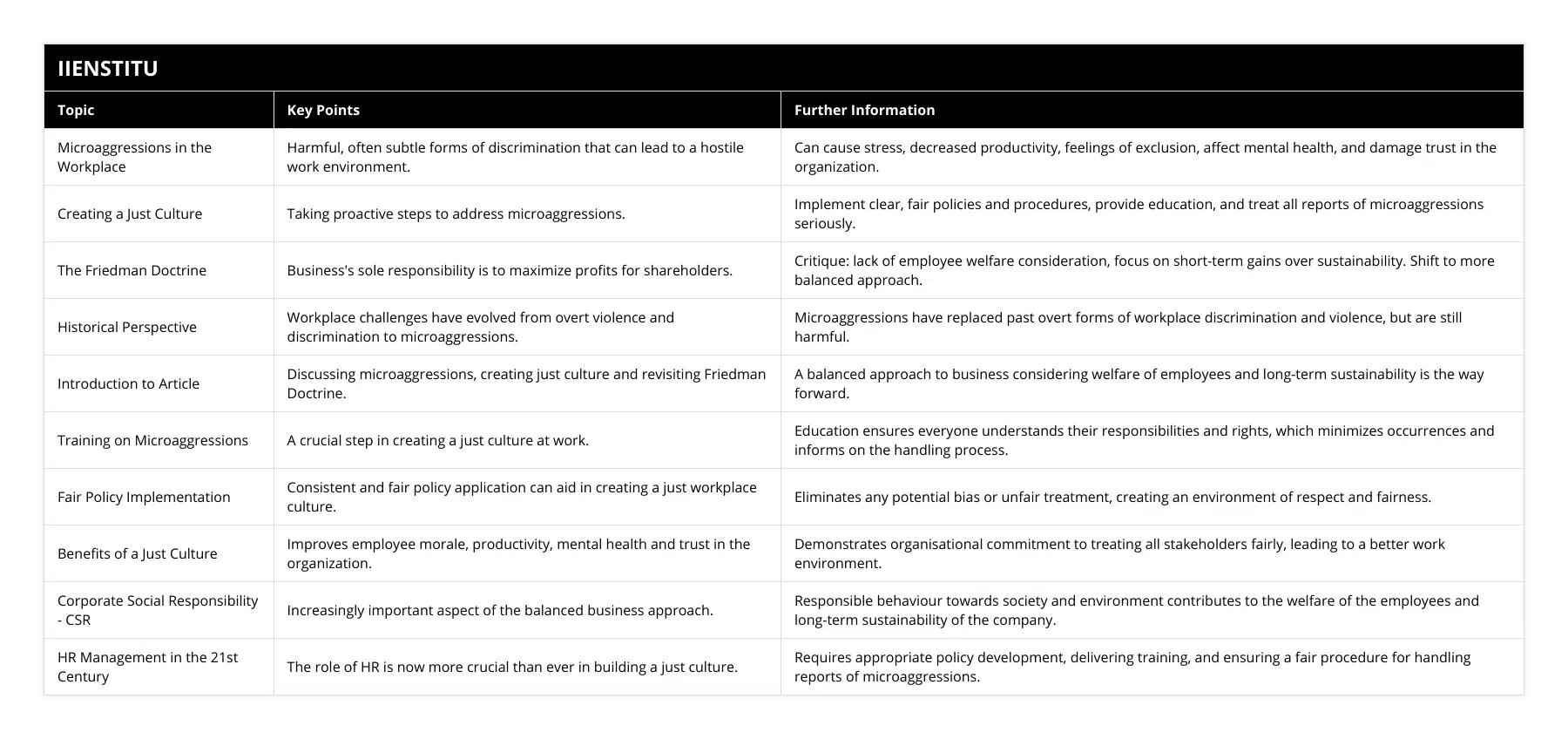
3- Damaged Reputation: In today's interconnected world, negative experiences can quickly become public, harming the organization's reputation and ability to attract top talent.
Steps to Creating a Just Culture
Creating a just culture isn't just a moral imperative--it's a strategic one. Strategic human resource management recognizes that employees are the organization's most valuable asset. So, how do we foster an environment where everyone feels valued and respected?
1. Clear Policies and Procedures
Organizations must ensure that their policies are clear, unambiguous, and consistently applied.
Establish Anti-Discrimination Policies: These should explicitly define what constitutes unacceptable behavior, including microaggressions.
Implement a probability and impact matrix guide for risk evaluation regarding workplace conduct issues.
Ensure Transparency: Employees should be aware of the policies and understand the consequences of violations.
2. Training and Education
Providing regular training helps employees recognize their own biases and understand the impact of their actions.
Diversity and Inclusion Workshops: These can open dialogues about unconscious biases and cultural sensitivity.
Communication Skills Training: Enhancing interpersonal skills can reduce misunderstandings.
Leadership Development Programs: Equip managers with the tools to lead diverse teams effectively.
3. Addressing Reports Promptly
When issues arise, they must be addressed swiftly and fairly.
Create Safe Reporting Channels: Employees should feel comfortable reporting incidents without fear of retaliation.
Investigate Complaints Thoroughly: Every report should be taken seriously and investigated by trained HR professionals.
Implement Corrective Actions: When necessary, apply appropriate consequences and provide support to affected individuals.
4. Foster an Inclusive Culture
Building a culture that celebrates diversity goes beyond policies--it's about daily practices.
Encourage Open Dialogue: Create spaces where employees can share their experiences and suggestions.
Recognize and Celebrate Differences: Cultural events, team-building activities, and acknowledgement of diverse contributions can enhance inclusivity.
Lead by Example: Leadership should model the behaviors they wish to see throughout the organization.
The Friedman Doctrine and Its Implications
In 1970, economist Milton Friedman famously asserted that "the social responsibility of business is to increase its profits" (Freeman, 1984). This perspective, known as the Friedman Doctrine, posits that a company's primary obligation is to its shareholders. While this approach emphasizes short-term gains, it often overlooks the long-term sustainability that comes from investing in employees and ethical practices.
Criticisms of the Doctrine
Neglect of Stakeholder Welfare: By focusing solely on profits, companies may neglect the well-being of employees, customers, and the community.
Ethical Considerations: Ignoring corporate social responsibility can lead to unethical practices that harm society and the environment.
Reputational Risks: In an age where information is readily accessible, unethical practices can damage a company's image, affecting profitability.
I once worked for a company that prioritized immediate profits over everything else. While the financial statements looked impressive for a few years, the lack of investment in human resources and employee development led to high turnover and declining innovation. Ultimately, the company couldn't sustain its initial success.
Shifting Towards a Balanced Approach in Business
Modern organizations are recognizing the importance of a more balanced approach--one that aligns with strategic HR management and considers the needs of all stakeholders.
Emphasizing Corporate Social Responsibility (CSR)
Environmental Sustainability: Adopting eco-friendly practices not only helps the planet but can also reduce costs.
Community Engagement: Supporting local initiatives builds goodwill and strengthens community ties.
Ethical Labor Practices: Ensuring fair wages, safe working conditions, and respect for workers' rights enhances employee loyalty.
Investing in Employees
Professional Development: Offering training and advancement opportunities helps retain top talent.
Wellness Programs: Supporting mental and physical health leads to a more productive workforce.
Inclusive Policies: Embracing diversity fosters creativity and innovation.
Long-Term Sustainability Over Short-Term Gains
Strategic Planning: Aligning business goals with sustainable practices ensures longevity.
Risk Management: Considering the probability and impact matrix guide for risk evaluation can mitigate potential issues before they escalate.
Customer Satisfaction: Happy employees often lead to satisfied customers, which drives repeat business and referrals.
Conclusion
Creating a just culture within the workplace is not just a lofty ideal--it's a necessity for modern businesses. Microaggressions, while subtle, can have profound negative impacts on both individuals and organizations. By taking proactive steps--such as establishing clear policies, providing training, and addressing issues promptly--employers can foster an environment where all employees feel valued and respected.
The outdated notion espoused by the Friedman Doctrine fails to account for the intricate human and resource dynamics that drive sustainable success. Resource HR isn't just about managing people--it's about harnessing human potential to achieve organizational goals. By shifting towards a more balanced approach that values employees as much as shareholders, businesses can thrive in the long term.
As we move forward, it's crucial for organizations to embrace strategic HR management strategies that prioritize inclusivity and ethical practices. After all, the true measure of a company's success isn't just in its profit margins but in the well-being of its people and the impact it has on society.
References
1- Green, P. C. (2017). Strategic Human Resource Management: A Guide to Action. New York: Palgrave Macmillan.
2- Sue, D. W. (2010). Microaggressions in Everyday Life: Race, Gender, and Sexual Orientation. Hoboken, NJ: John Wiley & Sons.
3- Freeman, R. E. (1984). Strategic Management: A Stakeholder Approach. Boston: Pitman Publishing Inc.
4- Robbins, S. P., & Judge, T. A. (2019). Organizational Behavior. Upper Saddle River, NJ: Pearson Education.
5- Dessler, G. (2020). Human Resource Management. Boston: Pearson.
It's up to each of us to contribute to a workplace that not only drives economic success but also honors the dignity and potential of every individual. Together, we can build organizations that are not just profitable but truly human resources in every sense of the word.
[2049 words]
Frequently Asked Questions
What are the key components of creating a just culture in HR management?
Creating a culture of justice and fairness within Human Resources management is essential for any organization to reach its full potential. In addition, a just culture requires understanding the importance of transparency, communication, and accountability. Each component is necessary for an organization to establish an effective HR management system.
Transparency is a critical component in creating a just culture, as it ensures that all employees are aware of the rules and expectations the organization has set. Transparency also allows employees to understand the consequences of their actions, as well as to understand the decision-making process. Ensuring that the organization communicates openly and honestly will enable employees to make informed decisions based on clear expectations and information.
Communication is also an important component in establishing a just culture. Communication between management and employees is essential to ensure that everyone is on the same page and that the organization makes decisions in the best interest of all parties involved. In addition, communication should be ongoing and transparent, allowing for a deeper understanding of the organization’s mission and goals.
Finally, accountability is a crucial component in creating a just culture. Organizations should have systems that ensure accountability for all employees, from management to entry-level staff. This includes ensuring that all employees are held to the same standards, regardless of their position or job title. By having a clear set of expectations and consequences for violations, employees will be more likely to adhere to the organization’s policies and procedures.
In conclusion, the critical components of creating a just culture in HR management include transparency, communication, and accountability. By implementing these components, an organization can create a workplace environment that is fair and equitable for all employees. This environment will improve performance and increase employee job satisfaction, benefitting the organization.
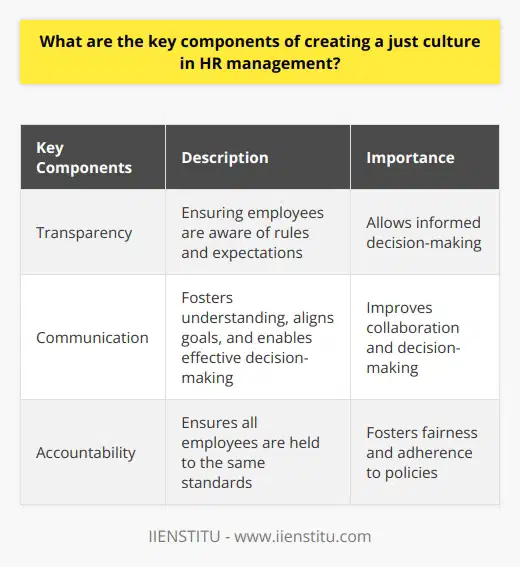
How can microaggressions in the workplace be addressed to create a just culture?
Organizational justice has been identified as a critical factor in the success of any organization, and microaggressions in the workplace can significantly negatively impact the overall sense of justice and inclusion. Microaggressions are subtle yet pervasive forms of discrimination and prejudice, often expressed through verbal and nonverbal behavior. These behaviors can be intentional or unintentional, but their cumulative effects can damage the workplace environment. Therefore, organizations must create next, organizations a just culture by addressing microaggressions in the workplace.
One of the first steps in addressing microaggressions is to recognize the prevalence of the behavior in the workplace. Next, organizations should strive to create a safe and supportive environment for employees by raising awareness of the impact of microaggressions and providing training on how to recognize and address them. Finally, organizations should also encourage open dialogue between employees and managers, in which employees can express their concerns and managers can listen to their perspectives and respond appropriately.
Organizations should also consider implementing policies and procedures that provide clear expectations for appropriate behavior and address any incidents of microaggressions quickly and effectively. For example, organizations can develop a zero-tolerance approach for microaggressions and provide training on recognizing and responding to them. This can be done through workshops, seminars, and other educational materials.
Finally, organizations should strive to create a workplace culture that values diversity and inclusion. This can be achieved through mentorship programs, diversity and inclusion training, and employee resource groups. These initiatives can help create a sense of belonging and foster a more inclusive environment for all employees.
In conclusion, organizations can create a just culture by recognizing the prevalence of microaggressions in the workplace and taking appropriate steps to address them. By raising awareness, providing training and resources, and creating a workplace culture that values diversity and inclusion, organizations can ensure that all employees feel safe, respected, and loved.
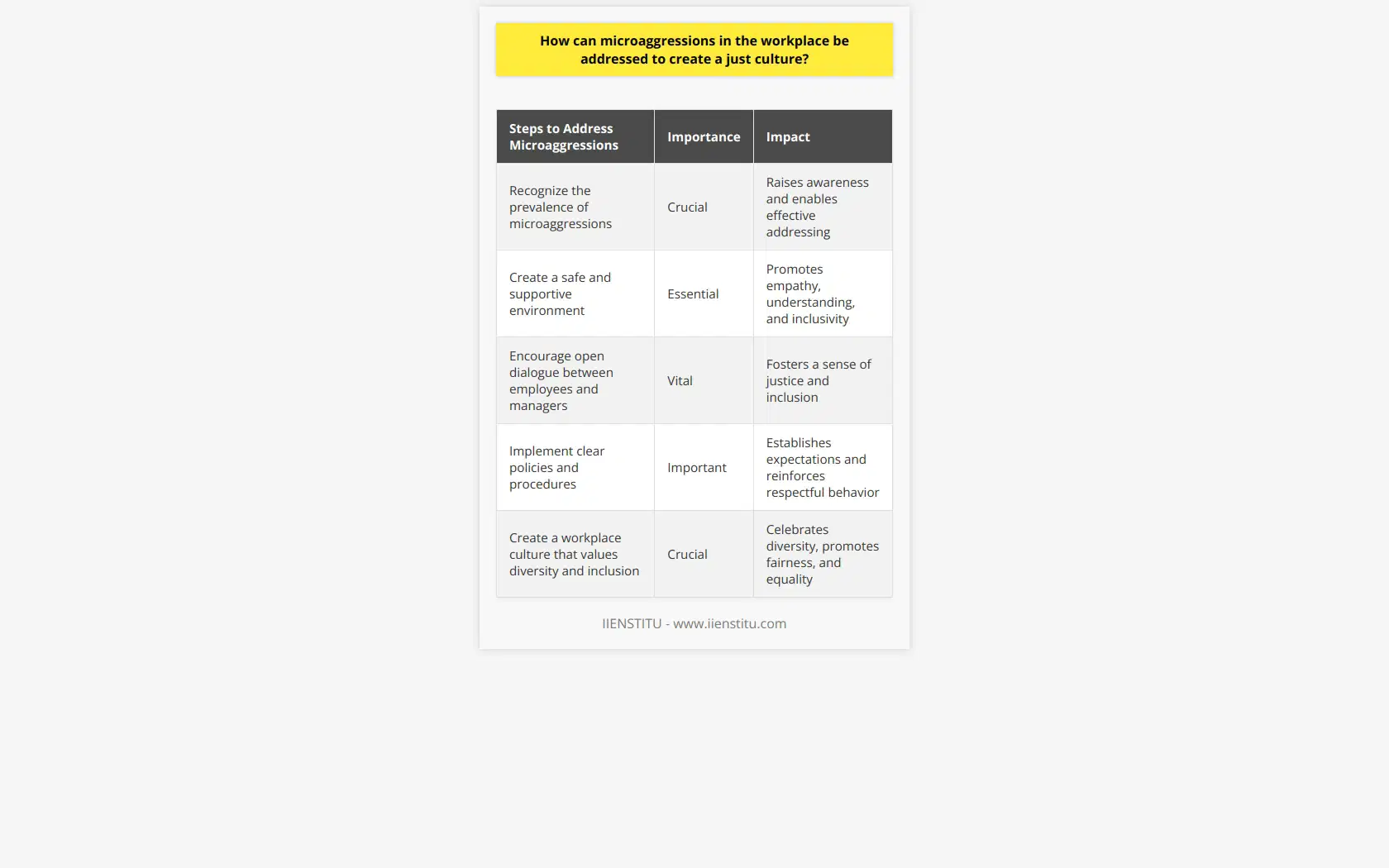
What is the Friedman Doctrine and how does it relate to creating a just culture in HR management?
The Friedman Doctrine is an economic theory proposed by Nobel Laureate Milton Friedman in 1970. According to the Friedman Doctrine, a business’s sole responsibility is to increase its profits. In addition, the doctrine suggests that companies should not be concerned with social interests or civic duties and should prioritize their interests and those of their shareholders.
The Friedman Doctrine has been widely debated amongst economists, with some arguing that it ignores broader social responsibilities and ethical considerations. However, its influence on corporate culture has been undeniable, and its implications for managing human resources (HR) are significant.
The Friedman Doctrine has increased emphasis on the bottom line within organizations and an increased focus on efficiency and cost-cutting measures. This has resulted in a shift from a culture of loyalty and dedication to a culture of short-termism and cost-effectiveness. In HR, this has resulted in a greater emphasis on performance-based rewards, a greater focus on short-term goals, and a tendency to prioritize cost-cutting measures over long-term investments.
The long-term implications of this type of culture are significant. It can lead to a lack of job security, a lack of job satisfaction, and a lack of commitment to the organization. It can also lead to a greater risk of unethical behavior and a lack of trust between employees and management.
Organizations must challenge the Friedman Doctrine and look beyond the bottom line to create a more just culture within HR management. Organizations must prioritize the needs of their employees and strive to develop a culture of loyalty, commitment, and job satisfaction. This can be achieved through various measures, including investing in employee development, valuing employee input, creating a positive workplace environment, and rewarding employees for their hard work and dedication.
In conclusion, the Friedman Doctrine has profoundly influenced corporate culture, particularly in the area of HR management. To create a more just culture within HR, organizations must reject the Friedman Doctrine and focus on creating a culture of loyalty, commitment, and job satisfaction.
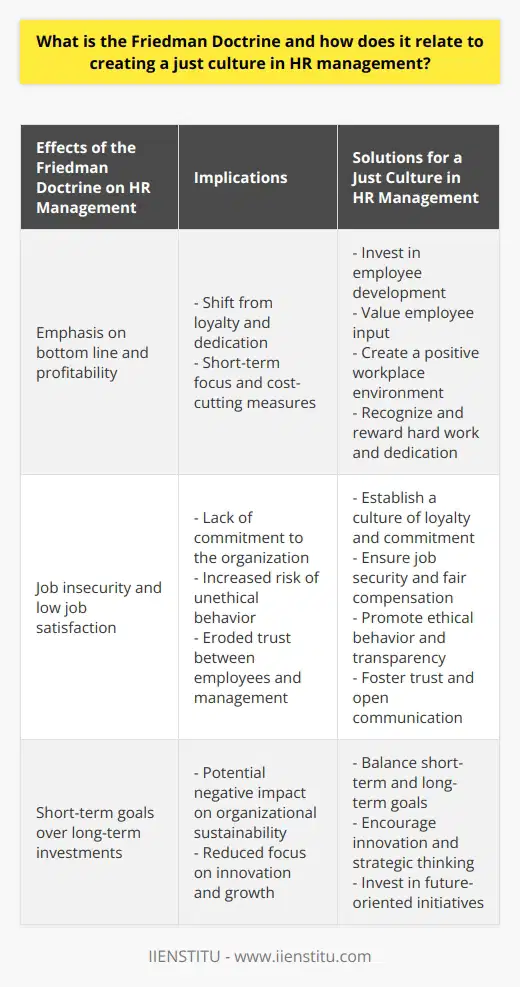
What are the essential characteristics of a just culture in the context of human resource management?
Essential Characteristics of a Just Culture
In the context of human resource management, the creation and maintenance of a just culture is crucial for promoting fairness, transparency, and equity within organizations. A just culture consists of the following essential characteristics:
Mutual Respect and Trust:
One of the core features of a just culture is mutual respect and trust among employees and management. This implies that employees are treated with dignity and fairness, trust is maintained between management and employees, and fairness is promoted within the organization.
Clear Expectations and Accountability:
Another essential characteristic of a just culture is that it has clear expectations and accountability measures for all employees. This ensures that everyone is aware of the performance expectations and responsibilities associated with their roles, and the consequences of not meeting them.
Ongoing Communication:
A just culture promotes regular and open communication, fostering transparency and a shared understanding of the organization's goals, values, and priorities. This includes providing ongoing feedback for improvement and giving credit where it's due.
Support for Learning and Growth:
A just culture actively encourages learning and growth, providing ongoing opportunities for employees to develop their skills and career potential. This means offering continuous training, career development courses, and other resources to enhance employees' abilities and increase their chances for future success.
Reward and Recognition:
In a just culture, employees are rewarded and recognized for their achievements, contribution, and performance. Through incentives, accolades, and promotions, employees feel valued, and their hard work is acknowledged.
Emphasis on Ethical Decision-making:
Ethical decision-making is a key component of a just culture, which encompasses making fair and unbiased decisions that prioritize the well-being and interests of all employees. This involves adhering to legal and ethical standards and implementing practices to combat favoritism and biased behavior.
Incorporating a just culture within an organization's human resource management practices brings numerous benefits. It creates a positive work environment that fosters respect and trust, improves employee satisfaction and engagement, and ultimately enhances the overall performance and productivity of the organization.
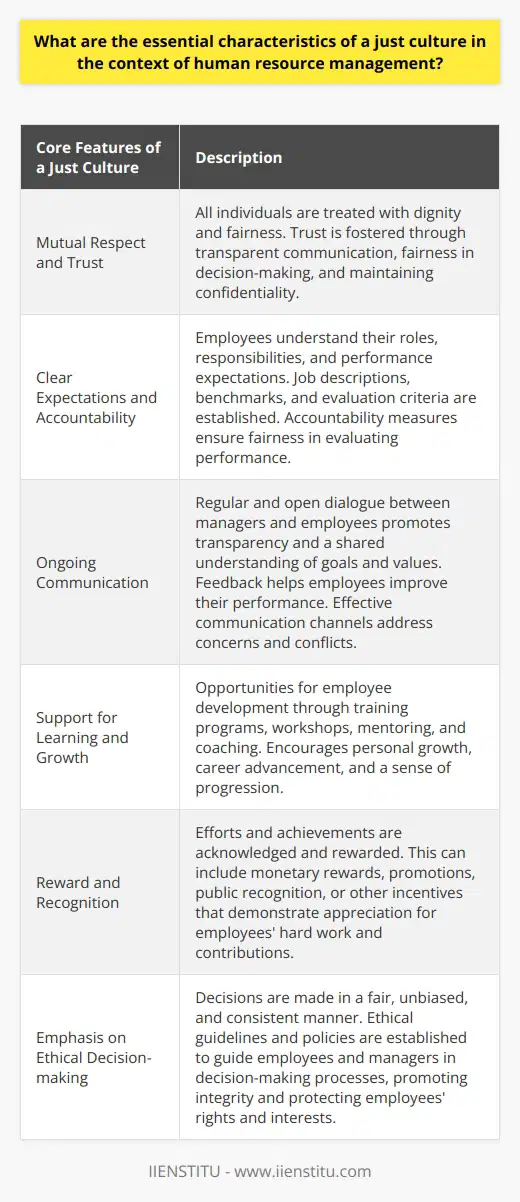
How does the implementation of just culture principles contribute to improved organizational performance and employee well-being?
Just Culture Principles and Organizational Performance
One significant way that implementing just culture principles contributes to improved organizational performance is through fostering a sense of fairness and trust among employees. When team members believe that their work environment is equitable and transparent, they are more likely to engage in collaborative problem-solving, which can lead to increased innovation and productivity. Furthermore, employees who trust that their organization will fairly address issues are more committed to achieving the company's goals, thereby enhancing overall performance.
Enhancing Employee Well-being
The implementation of just culture principles also has a direct impact on employee well-being. A just, psychologically safe work environment enables individuals to openly discuss errors and learn from them without fear of retribution. This open communication helps reduce stress levels and burnout, as employees are not constantly anxious about potential punishment or blame. As a result, employee well-being is improved, further promoting the development of a positive work culture.
Error Reporting and Continuous Improvement
When just culture principles are in place, employees feel comfortable reporting errors and near-misses. This willingness to report issues creates an environment of continuous improvement, driving the organization to learn from mistakes and make necessary changes to improve processes and prevent future incidents. Consequently, implementing a just culture contributes to a more efficient and effective workplace, reflecting positively on organizational performance.
Promoting Employee Engagement
Employee engagement is another critical aspect of organizational performance that benefits from the implementation of just culture principles. By ensuring that employees are treated fairly and with respect, they are more likely to feel valued and invested in the organization's success. Engaged employees are highly motivated, demonstrating increased productivity and contributing directly to the achievement of organizational goals. In addition, improved employee morale and satisfaction tend to reduce employee turnover, which positively affects the organization's bottom line.
In conclusion, the implementation of just culture principles plays a pivotal role in enhancing organizational performance and employee well-being. By fostering trust, promoting employee engagement, encouraging error reporting, and facilitating continuous improvement, just culture helps organizations to develop a more positive, efficient, and motivated workforce.
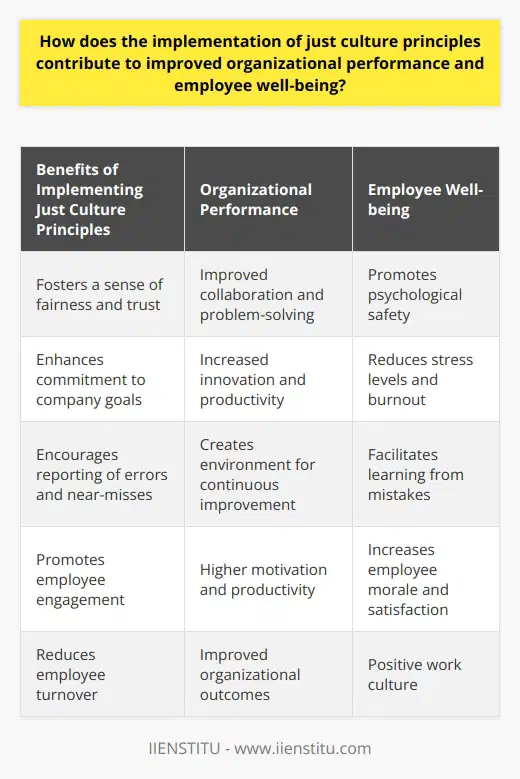
In what ways can HR professionals address and mitigate unconscious biases to promote a just culture within their organizations?
Addressing Unconscious Biases
Unconscious biases, pervasive in every organization, can create disparities and hinder diversity efforts. To promote a just culture, HR professionals must acknowledge and neutralize these biases. They can implement various strategies, including raising awareness, employing objective assessment tools, and fostering an inclusive workplace culture.
Raising Awareness of Unconscious Biases
One crucial way to mitigate unconscious biases is through targeted training to increase awareness. HR professionals can provide workshops or seminars that help employees recognize their own biases and understand how these affect their behavior and decision-making processes. By educating the workforce, an organization can decrease the prevalence of biases and foster a more equitable environment.
Utilizing Objective Assessment Tools
To reduce the impact of unconscious biases in recruitment, performance evaluations, and promotions, HR professionals can implement data-driven and objective assessment tools. These tools may include structured interviews that eliminate subjective factors, standardized performance review criteria, and blind recruitment processes that conceal applicant demographics. Relying on objective tools can improve fairness and create a more level playing field for all employees.
Fostering an Inclusive Workplace Culture
Finally, HR professionals can cultivate an inclusive workplace by encouraging open communication and valuing diverse perspectives. This may involve hosting regular events like town hall meetings, where employees can share views and experiences, or forming Employee Resource Groups that focus on specific aspects of diversity. By celebrating multiple viewpoints, HR professionals can foster a sense of belonging and inclusivity, which can greatly decrease the impact of unconscious biases.
In conclusion, HR professionals play an essential role in addressing and mitigating unconscious biases in the workplace. By raising awareness, employing objective assessment tools, and fostering an inclusive environment, they can reduce disparities and promote a just and equitable culture within their organizations.
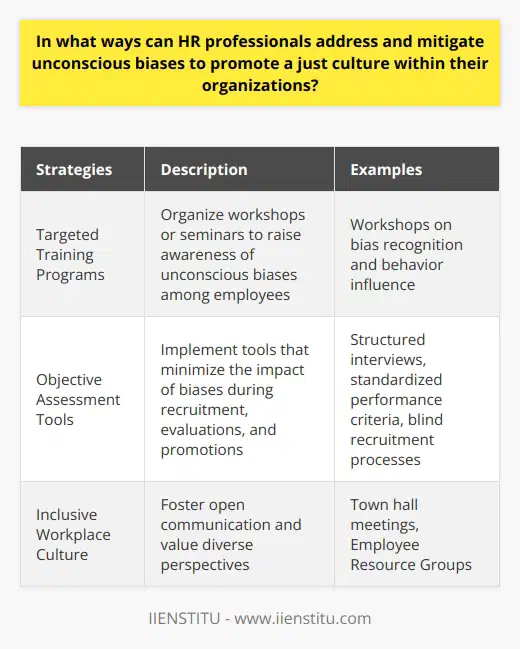
What is the role of empathy and open communication in establishing a just culture within an organization?
Role of Empathy in a Just Culture
Empathy plays a crucial role in establishing a just culture within an organization as it fosters an environment of understanding and compassion. When leaders demonstrate empathy, they create a sense of belonging and inclusion among team members, which promotes equity and fairness. By putting themselves in the shoes of their employees, leaders are better equipped to identify and address potential areas of injustice, contributing to a more harmonious and respectful workplace.
Open Communication as a Catalyst for Justice
Open communication is another vital component in creating a just culture. By facilitating transparent communication channels, organizations enable employees to voice their concerns, opinions, and ideas without fear of retribution. Consequently, open communication cultivates a collaborative environment where individuals feel valued for their unique perspectives, paving the way for diversity and inclusion. Moreover, transparent communication leads to greater awareness of systemic injustices and fosters collective responsibility to rectify these issues, ultimately promoting a fairer organizational culture.
Empathy and Open Communication in Decision-making
Incorporating empathy and open communication within decision-making processes further strengthens a just culture. Empathetic leaders consider the needs and perspectives of various stakeholders before implementing policies, thus ensuring that decisions are fair and equitable. Additionally, open communication allows for diverse input and inclusive participation in decision-making processes. This level of involvement and collaboration helps to eliminate potential biases and prejudice, resulting in more objective and well-rounded decisions that contribute to a just organizational culture.
Addressing Conflicts and Challenges
The presence of empathy and open communication also promotes constructive conflict resolution and a proactive approach to addressing challenges. By expressing empathy towards differing viewpoints, leaders encourage healthy debates, fostering creative problem-solving, and innovation. Open communication enables individuals to address issues directly and collaboratively, further promoting a just culture. By actively engaging in dialogue and demonstrating genuine concern for others, leaders can effectively address conflicts and create a more equitable working environment.
In conclusion, empathy and open communication are essential in establishing a just culture within an organization. Developing empathetic leadership and promoting transparent dialogue not only improve equity and fairness but also contribute to better decision-making, conflict resolution, and overall workplace harmony. As such, the cultivation of empathy and open communication should be prioritized within organizations to ensure a more diverse, inclusive, and just culture.
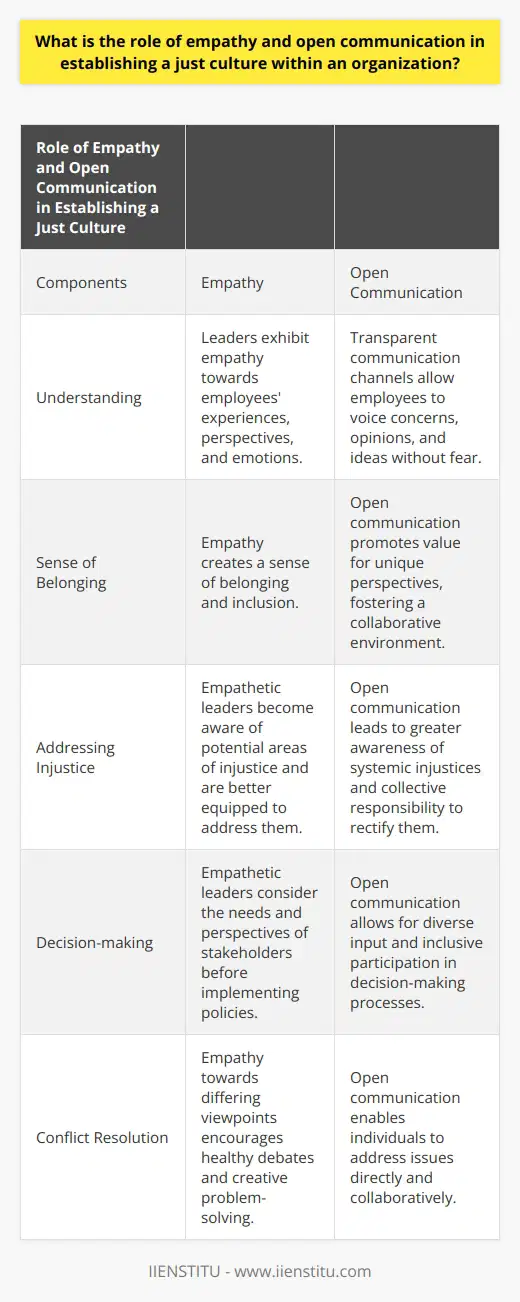
How can HR professionals ensure that policies and procedures are aligned with the principles of just culture?
Establishing Just Culture Principles
To guarantee that policies and procedures align with just culture principles, HR professionals must first comprehend the core tenets of just culture. This refers to an organization's commitment to cultivating trust, promoting accountability, and encouraging open communication about mistakes and concerns to improve overall performance and employee well-being.
Understanding the Organization's Values
HR professionals must begin by studying their organization's values and identifying gaps where just culture principles are not adequately represented. By thoroughly assessing the organizational climate, HR can pinpoint areas of improvement and take necessary steps to align policies and procedures more closely with just culture values.
Creating Employee Awareness
Once the organization's values are properly understood, HR professionals must disseminate this knowledge among employees to raise awareness of just culture principles. This can be achieved through training programs, workshops, and regular communication, empowering employees to incorporate these principles into their work routines and providing a platform for raising concerns or reporting potential issues.
Reviewing Policies and Procedures
HR professionals must periodically evaluate existing policies and procedures, ensuring their alignment with just culture values. Amending outdated policies or creating new ones that promote fairness, transparency, and employee participation will demonstrate the organization's commitment to just culture principles and show dedication to continuous improvement.
Implementing Accountability Measures
A crucial element of just culture is promoting a sense of responsibility and accountability within the organization. HR professionals can foster this by implementing performance management systems that emphasize shared accountability and constructive feedback, promoting an atmosphere where employees can learn from their mistakes without fear of retribution.
Facilitating Open Communication
By establishing channels for open communication, HR professionals can encourage employees to voice concerns, report incidents, and suggest improvements. This atmosphere of openness and trust will reinforce the organization's commitment to just culture and allow for the identification and remediation of potential issues before they escalate.
Monitoring Progress and Adaptation
Finally, HR professionals must continuously monitor the progress of policies and procedures to ensure their ongoing alignment with just culture principles. Regular audits, employee surveys, and stakeholder feedback can provide valuable insights into the effectiveness of these initiatives and inform any necessary adaptations to better serve the organization's needs.
By taking these steps, HR professionals can contribute significantly to fostering a just culture within their organization, ensuring that policies and procedures are built on a solid foundation of trust, fairness, and open communication. This will not only lead to improved performance and employee well-being, but also enhance an organization's reputation as a responsible and ethical employer.
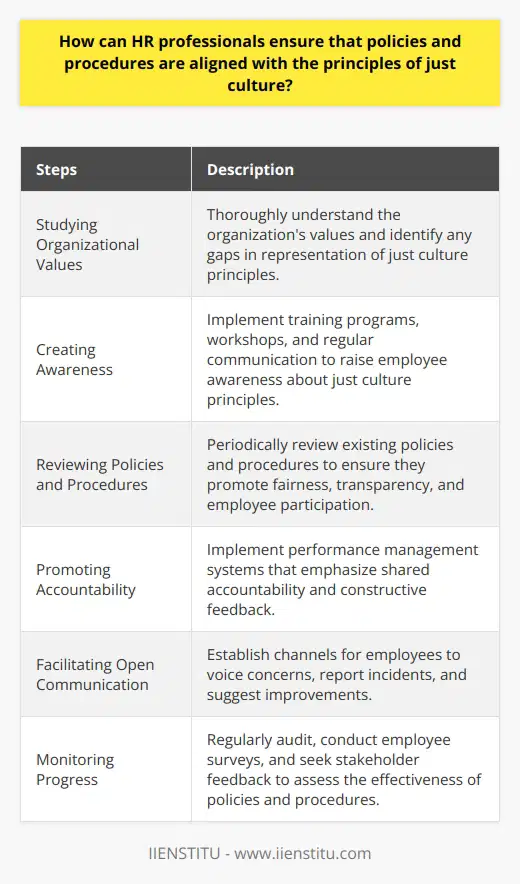
What are some common barriers to establishing a just culture in the workplace, and how can HR professionals overcome them?
Identifying Barriers
One common barrier to establishing a just culture in the workplace is the fear of change among leaders and employees. This fear can manifest in resistance to new policies or procedures, resulting in a continuation of unjust practices. Another barrier is the lack of awareness about the importance of a just culture, which can lead to disinterest in addressing the issue. Additionally, unconscious biases among staff and management can perpetuate unequal treatment and hinder the development of a fair work environment. Furthermore, the absence of clear communication channels and policies can exacerbate misunderstandings and inequality in treatment among employees.
Addressing Fear and Resistance
To overcome the challenges of establishing a just culture in the workplace, HR professionals must address the fear and resistance among leaders and employees. By providing training sessions and workshops centered around the benefits of a just culture, HR can educate individuals on the importance of implementing these practices. Including leaders and employees in discussions and decision-making processes can also foster a sense of ownership and accountability in building a just work environment.
Raising Awareness
Building and maintaining awareness about the importance of a just culture is crucial. HR professionals can conduct continuous learning sessions, invite guest speakers, or provide information through newsletters and intranet articles. By consistently highlighting the value of a just and inclusive work culture, HR can encourage employees and leaders to support these efforts actively.
Combatting Unconscious Biases
Addressing unconscious biases is vital to fostering a just culture in the workplace. HR professionals can provide training to help employees and leaders identify and overcome their biases. This process might involve conducting workshops or offering educational resources, promoting self-reflection, and accountability. By openly discussing individual biases and exploring ways to navigate them, a more inclusive work environment can be achieved.
Developing Clear Communication Channels and Policies
Finally, HR professionals should create and implement clear policies, guidelines, and communication channels that promote just practices. Ensuring fair practices in hiring, promotions, and disciplinary actions are essential in creating an equitable environment. A framework that encourages open dialogue and feedback can help employees feel more comfortable addressing concerns and contribute to a continuous improvement process in creating a just workplace culture.
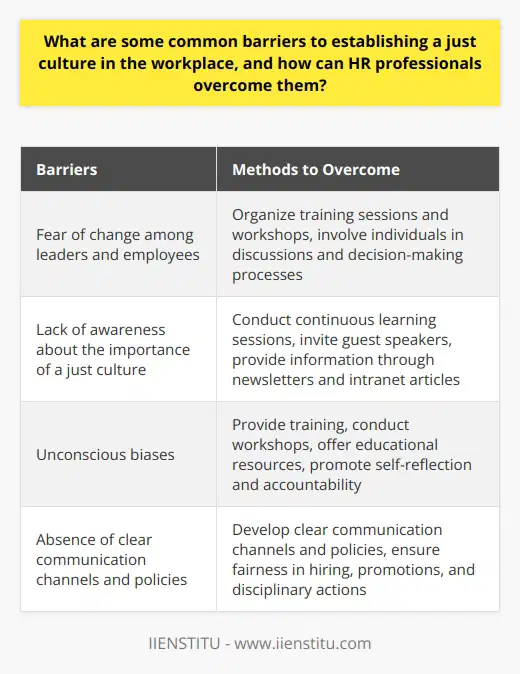
What are the key principles of Just Culture in HR, and how do they contribute to a more equitable and inclusive work environment?
**Just Culture Principles**
The key principles of Just Culture in human resources (HR) encompass accountability, transparency, learning, and fairness. These principles aim to create a more equitable and inclusive work environment by promoting healthy communication, trust, and a shared sense of responsibility.
**Accountability and Responsibility**
In a Just Culture, employees are held accountable for their actions and decisions, fostering an environment where individuals take responsibility for their performance. This sense of ownership not only encourages employee growth but also nurtures mutual respect and collaboration among team members.
**Transparency and Open Communication**
Just Culture emphasizes open communication and transparency throughout the organization. By encouraging honest dialogue, organizations can identify potential issues, gather feedback, and address concerns in a timely and efficient manner. This practice also helps to minimize conflicts and misunderstandings, contributing to a more harmonious work environment.
**Learning and Improvement**
Organizations that embrace Just Culture prioritize continuous learning and improvement, creating an atmosphere where employees feel empowered to grow, both personally and professionally. By recognizing that mistakes are opportunities for learning, HR can facilitate constructive discussions and develop strategies to enhance organizational performance.
**Fairness and Equity**
Lastly, Just Culture emphasizes fairness and equity, cultivating an environment in which all employees feel valued and treated equally, regardless of their background or position within the organization. This principle necessitates unbiased decision-making and ensures that employees receive objective feedback, leading to heightened trust and employee satisfaction.
In summary, the principles of Just Culture in HR play a critical role in fostering a more equitable and inclusive work environment. By emphasizing accountability, transparency, learning, and fairness, organizations can create a culture that supports the well-being and growth of all employees, ultimately enhancing overall performance and productivity.
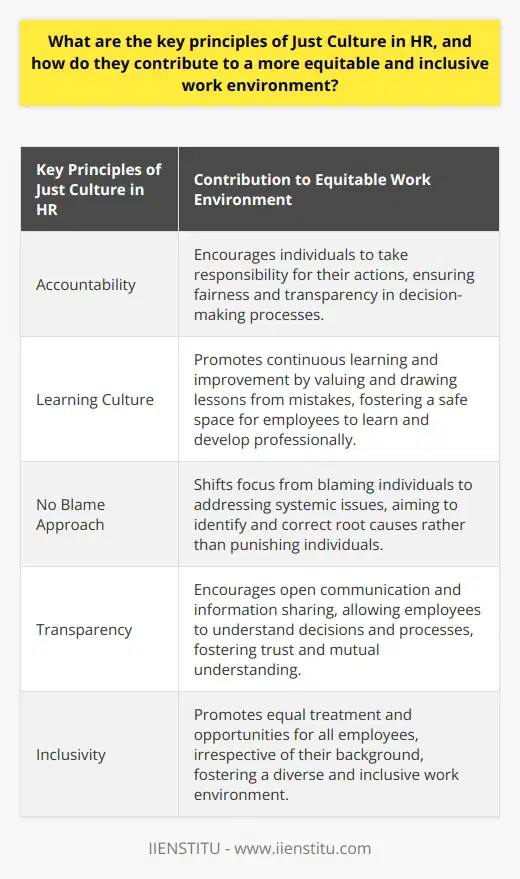
How can human resource management foster a just culture by addressing power imbalances and promoting diversity and inclusion in the workplace?
Addressing Power Imbalances
To foster a just culture, human resource management (HRM) must focus on addressing power imbalances in the organization. This can be done by ensuring fair treatment of employees, regardless of their position or background. HRM can implement policies that prevent discrimination and harassment, demonstrating the organization's commitment to creating an equitable environment for all staff members. Moreover, HRM can facilitate communication channels between different hierarchical levels, allowing employees to voice their concerns without fear of retaliation.
Promoting Diversity and Inclusion
Central to creating a fair and just culture, HRM must actively promote diversity and inclusion in the workplace. Hiring practices should focus on attracting and recruiting diverse talent, ensuring the organization benefits from a broad range of perspectives and expertise. HRM can also implement diversity training programs to educate employees on the importance of inclusion, cultivating an open-minded and respectful work environment. Furthermore, HRM can establish employee resource groups for minority populations, encouraging connection and support amongst colleagues.
Measuring Success
To evaluate the effectiveness of these initiatives, HRM should develop metrics to measure the success of addressing power imbalances and promoting diversity and inclusion. By tracking progress, HRM can identify areas that require improvement and continually refine policies and practices. Possible metrics to consider include employee engagement and satisfaction surveys, diversity and inclusion indicators, and the number of discrimination and harassment complaints. In conclusion, fostering a just culture requires human resource management to address power imbalances and promote diversity and inclusion actively. By implementing the measures outlined above, organizations can ensure they create an equitable and inclusive work environment where employees feel valued and respected.
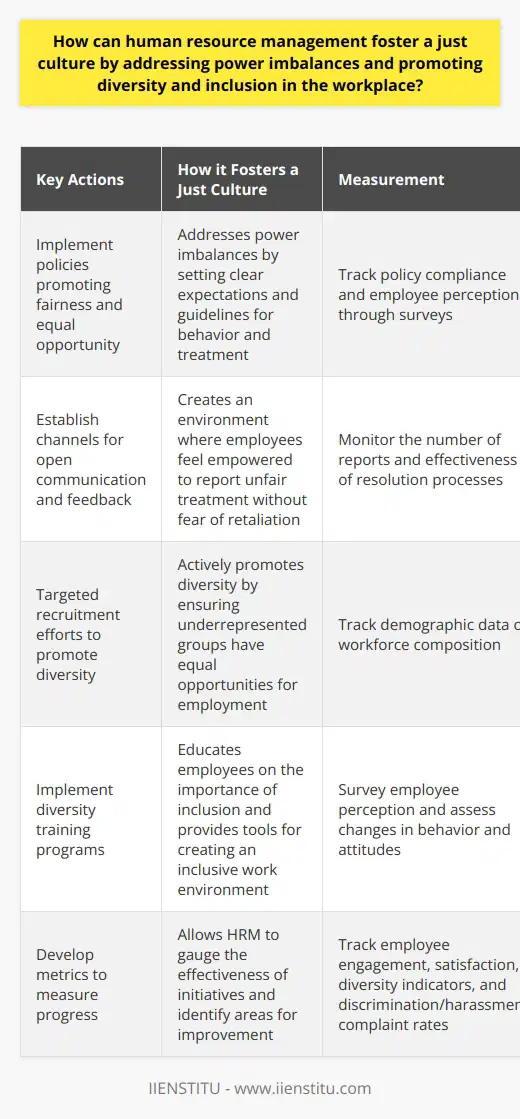
In light of the rapid technological advancements and globalization, how can HRM ensure the implementation of just culture principles to address the evolving needs and expectations of the workforce in the 21st century?
Adapting HRM Strategies to Technological Advancements and Globalization
As technology advances at a rapid pace and globalization connects the world like never before, human resource management (HRM) must adapt to the shifting landscape by implementing just culture principles. To effectively address the evolving needs and expectations of the workforce in the 21st century, HRM professionals should focus on the following strategies.
Prioritizing Diversity and Inclusion
One of the key challenges brought on by globalization is the increased diversity within workforces. HRM must endeavor to create inclusive environments that celebrate the value each employee brings to the organization. Implementing diversity training and policies will help to promote cultural sensitivity and understanding among team members.
Leveraging Technology for Training and Development
The integration of technology into human resource management is essential for growth and development. By harnessing innovations in digital learning, HRM can offer employees the opportunity to develop critical skills that align with the organization's goals. E-learning platforms and virtual training sessions can enable personalized learning experiences that cater to individual needs.
Fostering Employee Engagement
Employee expectations have shifted, with a growing emphasis on job satisfaction and work-life balance. HRM has the responsibility to recognize the importance of employee engagement and invest in strategies that foster positive and satisfying work environments. Employee well-being and satisfaction will lead to reduced turnover rates and higher productivity levels.
Embracing Remote and Flexible Work Arrangements
The digital age has made remote work and flexible working hours increasingly viable options for employees. HRM should recognize and adapt to the changing expectations of the modern workforce. Adjusting policies and procedures to accommodate these arrangements will increase employee retention and satisfaction, while also expanding the organization's talent pool.
Continual Assessment and Improvement
A just culture in HRM requires an ongoing commitment to self-assessment and continuous improvement. HRM professionals must remain abreast of evolving best practices and technological developments, and integrate these insights into their management strategies. This proactive approach will ensure HRM evolves alongside the changing workforce, always meeting the needs and expectations of employees.
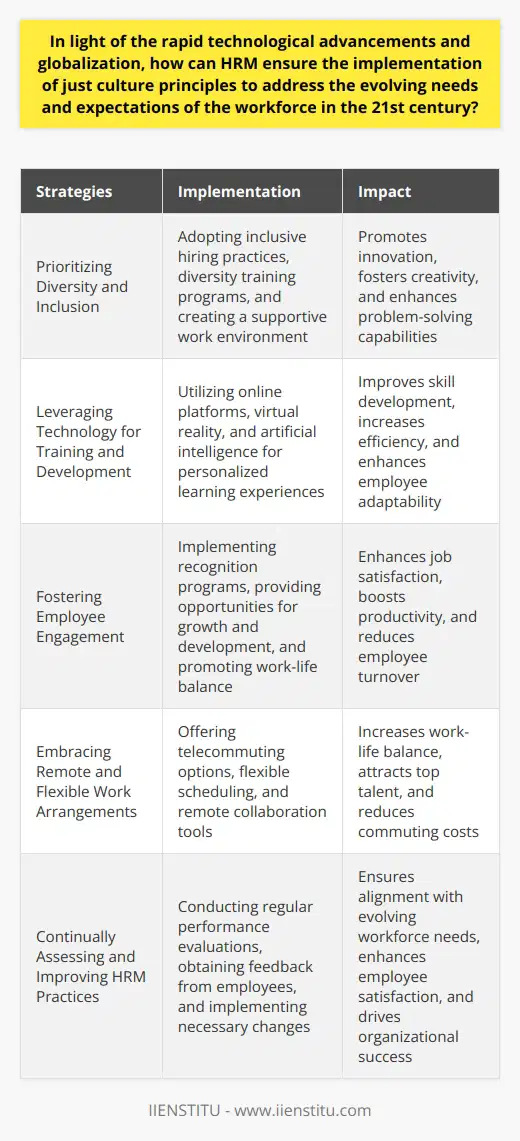
What is the impact of adopting Just Culture principles on talent acquisition and retention in HR?
Adopting Just Culture Principles and Talent Acquisition
When organizations adopt Just Culture principles, they significantly improve their talent acquisition strategies. These principles, emphasizing fairness, transparency, and accountability, attract prospects who value ethical operations. Job seekers today prefer organizations that promote fairness in decision-making and accountability for actions.
Positive Impact on Acquisition
In a Just Culture, every employee’s opinion matters, fostering a sense of respect and belonging. This inclusive environment appeals to diverse talent, broadening the organization's talent pool. Consequently, adopting Just Culture principles increases an organization’s ability to recruit top-notch professionals from varied backgrounds.
Just Culture Principles and Talent Retention
In terms of talent retention, Just Culture principles play a pivotal role. By fostering an environment of trust and respect, these principles enhance employee engagement and job satisfaction. Employees are more likely to stay in an organization where they feel valued and see growth potential.
Preventing Employee Turnover
With a Just Culture, employees have clear expectations and receive regular, constructive feedback. This reduces uncertainties and frustrations often linked with high turnover rates. Also, a Just Culture emphasizes learning from mistakes rather than punitive actions. This approach lowers employees' fear of risks, encouraging creativity, and innovation.
Improving Job Satisfaction
Moreover, a sense of justice and fair treatment leads to increased job satisfaction. When employees believe their organization treats them impartially, they feel happier and more fulfilled. This, in turn, boosts productivity and loyalty, further increasing the chances of talent retention.
In conclusion, adopting Just Culture principles has a profound positive effect on both talent acquisition and retention. It not only allows organizations to attract a diverse range of top talent but also enhances job satisfaction, employee engagement, and loyalty, ensuring talent retention. Thus, Just Culture principles are a strategic tool for HR in both attracting and keeping high-level talent.
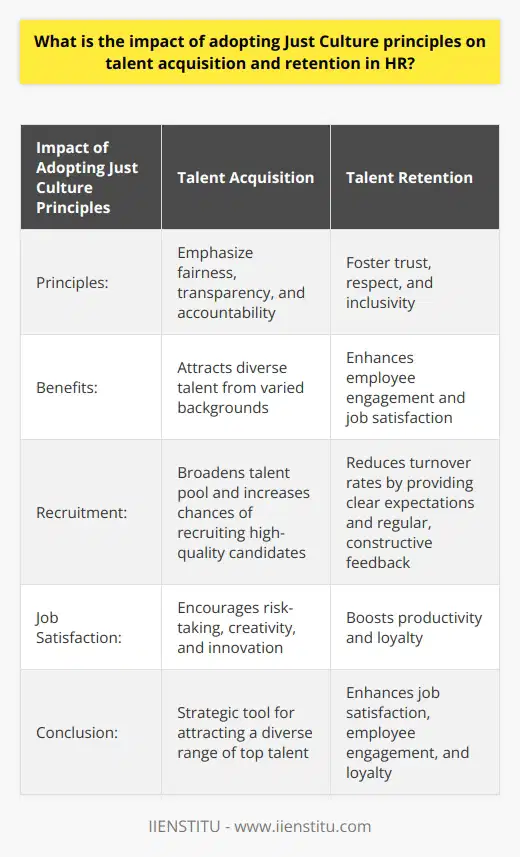
How do Just Culture initiatives in HR contribute to ethical decision-making and the organization's overall reputation?
Promotion of Just Culture in Human Resources
Just Culture initiatives in the Human Resources (HR) domain play a critical role in ethical decision-making. These initiatives contribute by encouraging openness, trust, and accountability among employees. HR managers begin by fostering an environment where employees feel safe to voice their concerns and ideas. This proactive approach allows employees to bring forward their ethical queries without fear of judgment or punishment. The reduced fear factor significantly aids in carving out moral decisions, promoting and reinforcing an ethical culture within the organization.
Enhancement of Ethical Decision Making
At the core of Just Culture initiative is learning from mistakes rather than punishing for them. This approach enhances the chances of ethical decision-making within the team. The focus shifts from blaming to understanding the cause of the error. It aids in preventing the recurrence of such mistakes by identifying and addressing systemic issues. Furthermore, continuous learning and improvement become an integral part of the organization’s culture. These qualities help in making informed and ethical decisions, strengthening the organization's moral fibre.
Impact on Organization's Reputation
Last but not least, the Just Culture approach significantly impacts an organization's reputation. When a company shows commitment towards fostering a Just Culture, it signals to stakeholders - both internal and external - that the organization values ethics and transparency. Transparency leads to trustworthiness, which in turn positively influences its image and reputation. Therefore, fostering a Just Culture can earn an organization a reputation as a trustworthy and ethical entity. This reputation can yield multiple benefits, including increased employee satisfaction, improved customer loyalty, and even competitive advantage in the marketplace.
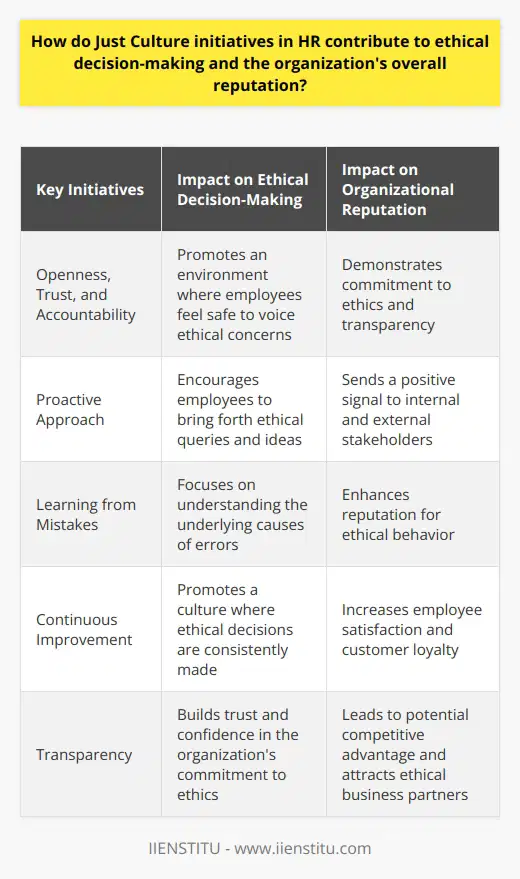
How can HR professionals navigate legal and ethical considerations when implementing Just Culture policies and practices within their organizations?
Understanding Legal Regulations
HR professionals should first consider laws and regulations related to their industry when implementing Just Culture policies. They must review employment contracts, labor laws, and any other relevant legal documents, ensuring the policies align with them. These could address discrimination, harassment, safety, and employee rights. Compliance shields the organization from potential legal disputes and preserves its reputation.
Promoting Ethical Conduct
The foundation of a Just Culture is ethics. HR professionals can foster this by promoting ethical behavior within their organization. They must develop clear and concise ethical guidelines. These should align with the company's values and serve as a standard for employee actions. By upholding these guidelines, HR can create a workplace culture that treats all employees fairly and equitably.
Providing Regular Training
Regular training is vital to navigate legal and ethical considerations. Through training, employees will understand how they should conduct themselves. They can learn about various laws and ethics pertinent to their roles. It boosts their knowledge and supports them in making more informed decisions.
Maintaining Confidentiality
HR should observe strict confidentiality when implementing Just Culture policies. They should take steps to protect sensitive information. This supports trust and honesty in the organization. It shows employees that the company respects their privacy, inspiring them to support the policies.
Emphasizing Transparency
Transparency is vital in ethical decision-making. By being open about their decision-making process, HR can show that they are fair and unbiased. It makes decisions easier to understand and accept. It also promotes an open dialogue between management and employees.
In conclusion, HR professionals can successfully navigate legal and ethical considerations by understanding legal regulations, promoting ethical behavior, providing training, maintaining confidentiality, and emphasizing transparency. These strategies not only ensure compliance with laws and regulations but also build trust in the organization, critical to the success of Just Culture policies.
